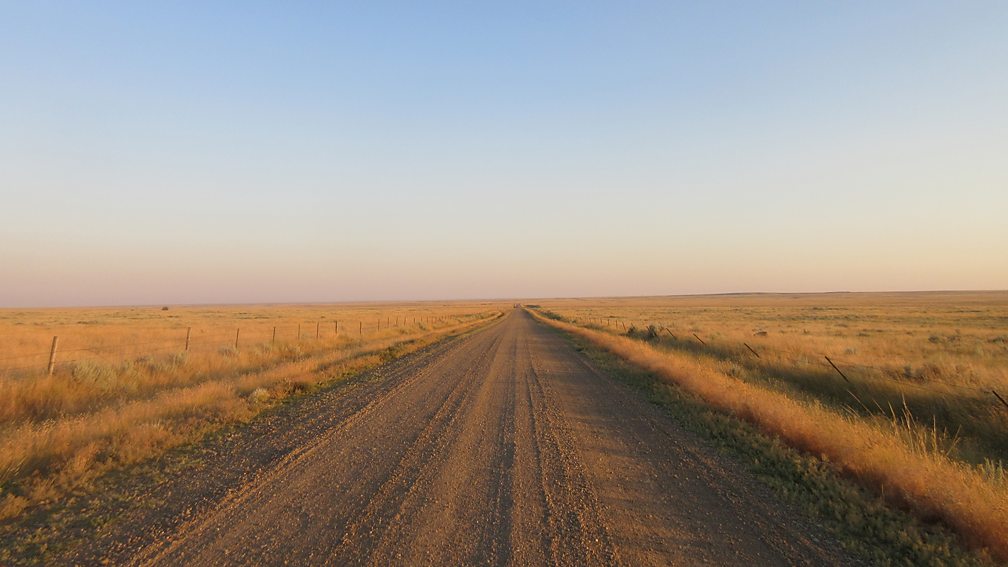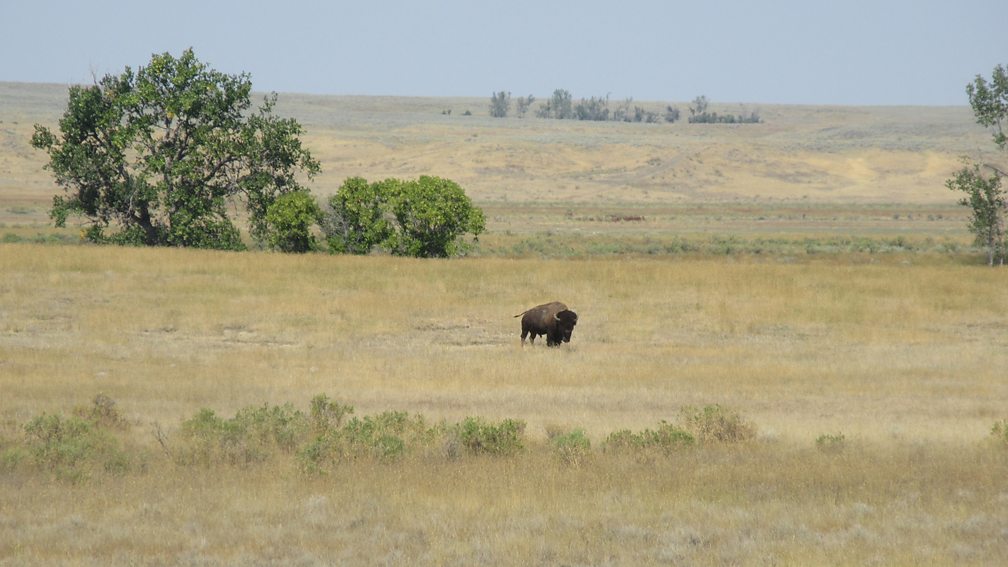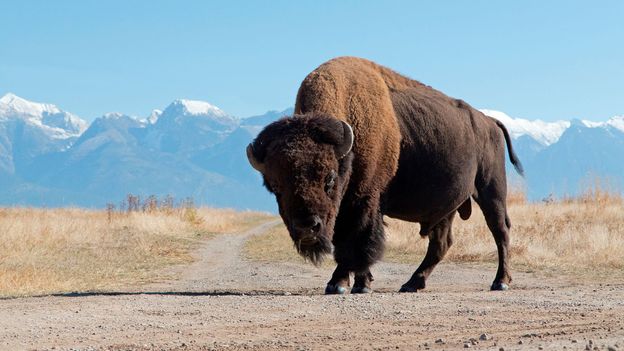
Why grazing bison could be good for the planet
American bison were hunted almost to extinction by European settlers. Now making a comeback, they could help reverse damage to prairies from decades of poor management.
Why grazing bison could be good for the planet
2nd November 2023, 08:00 EDTShare
By Christopher J PrestonFeatures correspondent

American male bison on prairie track (Credit: Getty Images)
American bison were hunted almost to extinction by European settlers. Now making a comeback, they could help reverse damage to prairies from decades of poor management.
It takes mettle to live on Montana's shortgrass prairie. It's dry, windy and a long way from anywhere. In summer, temperatures can top 100F (38C). In winter, the mercury plunges to -50F (-45C). In some spots, it is more than an hour's drive on gravel roads to buy a loaf of bread. When you get back, grasshoppers start cannibalising their brethren impaled on your car grille.
The indigenous Blackfeet, Nakoda and Gros Ventre peoples successfully adapted to the harsh environment over many centuries. More recently, a handful of hardy white settlers managed it too. Both left their mark on this forbidding land with fire, arrows and the plough. The shortgrass prairie makes up 71 million hectares (27,413 sq miles) of remote land straddling the US/Canadian border to the east of the Rocky Mountains. This rare habitat is in ecological decline. For the last 150 years, wildlife have surrendered the prime habitat to cows. Crested wheatgrass, a non-native plant seeded by European settlers for their cattle, paints swathes of land yellow in summer.
Today, though, parts of the landscape are being shaped by a different resident. This one sports a pair of black horns and a thick cape of curly brown hair.
The North American plains bison has a long history here, albeit one that suffered a brutal interruption. For a century and a half, their distinctive humped shoulders and bearded faces were missing from America's grasslands.
Tribes and conservation organisations have recently started bringing the bison back. And scientists studying the returns are discovering that getting the 2,000lb (900kg) grazer back in its native ecosystem could be key to the future of the prairie. When I visit one of these projects in summer 2023, wilting in the searing summer heat of the scorched prairie, I wonder what a giant, fur-covered herbivore is doing to help.
The bison's biggest service, I soon find out, is to assist the prairie in holding onto its water. Bison on the shortgrass prairie send a strong message about the importance of native grazers for landscape resilience. They may offer the prairie a lifeline as climate change tightens its grip.
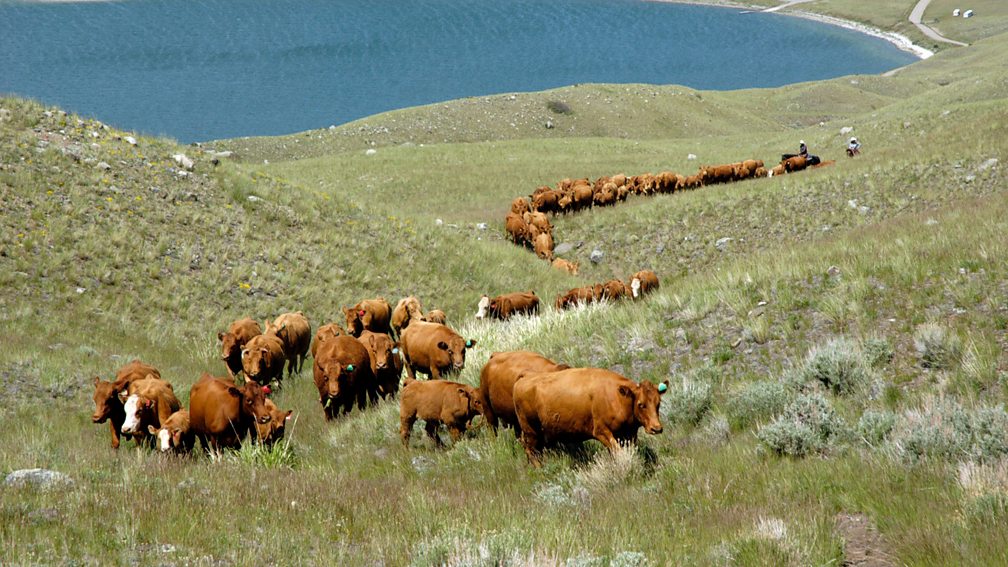
Getty Images
Cattle tend to congregate near water sources and if not moved regularly can destroy waterside vegetation (Credit: Getty Images)
Hila Shamon, a research ecologist with the Smithsonian's National Zoo and Conservation Biology Institute in Washington DC, has spent five years tracking the ecology of the remote grasslands.
She partners with American Prairie, a conservation organisation with parcels of land on either side of the million acre Charles M Russell National Wildlife Refuge, to study how bison are changing the ecosystem.
Shamon spends her field season crawling across American Prairie property measuring everything from vegetation density and species diversity to the habits of grassland birds and prairie dogs.
Shamon recently co-authored a study on prairie streams which suggests bison do something remarkable in this hostile environment. "There is no doubt, year-round grazing of bison is good for the landscape," she tells me. Bison, it turns out, have an ingrained capacity to boost biodiversity.
Plains bison co-evolved with the short-grass prairie. In the 12,000 years since the end of the Pleistocene, they have proven themselves to be potent ecosystem engineers.
An adult bison eats about 25lb (11kg) of grass a day. The grasses adapted to their foraging. Vegetation across the plains uses the nutrients in their dung. Birds pluck their fur from bushes to insulate their nests.
Bison also shape the land literally. They roll in the dust and create indentations known as "wallows" that hold water after rainstorms. After the bison move on, insects flourish in these pools and become a feast for birds and small mammals. Pronghorn antelope survive by following their tracks through deep winter snows.
Today, however, bison are getting a second chance
Plains bison spent thousands of years engineering a distinctive grassland ecology from Northern Canada through Montana to Mexico. But more than a century ago, this influence abruptly stopped. A few decades of slaughter led bison numbers to plummet from 60 million to barely 800 living wild in the US and Canada by 1889. Market forces and government policy replaced bison and native people with ranches, white settlement and cattle. For a hundred years, cattle claimed the prairie as their own. But while they were easier to turn into steaks, they were not as finely tuned for prairie life.
Today, however, bison are getting a second chance. Tribal reservations are at the forefront of their recovery, taking excess bison from Yellowstone National Park and restoring them to treaty lands. American Prairie is also playing a part, buying ranches and returning bison to places where cattle were once king. About 30,000 bison now exist in conservation herds in various parks and protected areas across the country. More than 10 times that number exist on bison farms.
Scientists like Shamon are watching it all closely to see how the return of bison affects the land.
"Cows don't move as much," Shamon says. When the weather gets hot, they gravitate to the creek bottoms for shade and the cooling water. When it's cold, cows hunker down behind creekside shrubs to shelter from the wind.
This preference for spending time in the riparian zone starts a vicious cycle. By browsing the trees and shrubs they reduce the amount of available shade, Shamon tells me. Their chewing means less leaf litter to cover the ground and, when the shrubs die, less roots to stabilise the stream banks. Over time, the soil around the creeks dries out, the boxelder, cottonwoods, wild rose and snowberry disappear, and the streambanks get taken over by non-native grasses. What was once a cooling refuge for wildlife becomes almost as forbidding as the uplands.
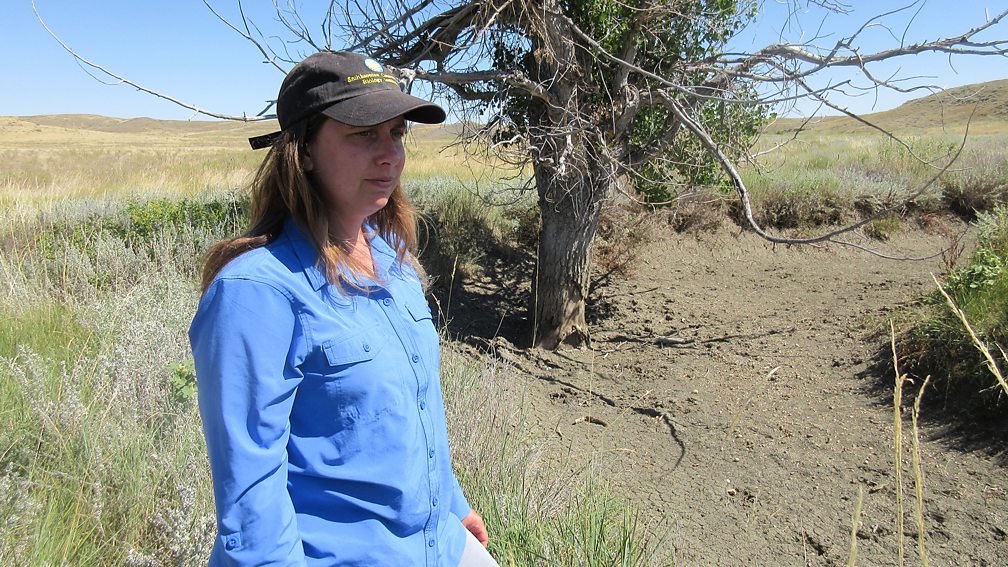
Christopher J Preston
Hila Shamon's research has found that bison can have a remarkably positive effect on the prairie environment (Credit: Christopher J Preston)
Bison, by contrast, are quite happy to tough it out on the prairie. It's what evolution finetuned them to do. They visit streams and ponds periodically to drink, but bison were built to keep moving. Unless the temperatures approach the hundreds, they generally don't bother spending time near creeks. They don't need as much shade. They prefer the grasses on the sunbaked uplands to woody shrubs in the river bottoms. As a result, they do less damage to creeks than cows.
Although rivers and streams cover less than 2% of the prairie, they are crucial refuges for its wildlife. Shamon's study shows increases in vegetation and bird diversity on creeks where bison have replaced cattle. She also found more deer and elk. Other studies show that year-round, low-density grazing by bison is associated with more variety in woody vegetation heights and more native plant diversity in riparian areas than seasonal grazing by cattle. Well-vegetated creeks are the prairie's lifeblood. They keep the soil moist, the vegetation green, and they provide dispersal corridors for large mammals like mountain lions and black bears. One day, they may provide safe passage for recovering grizzly bears.
